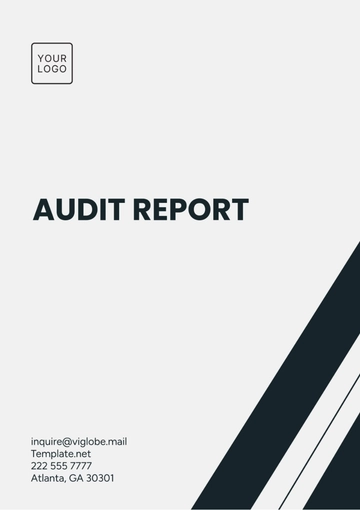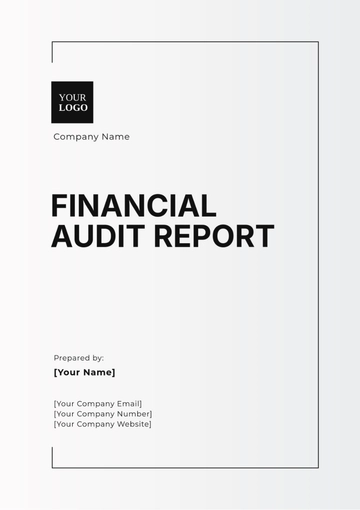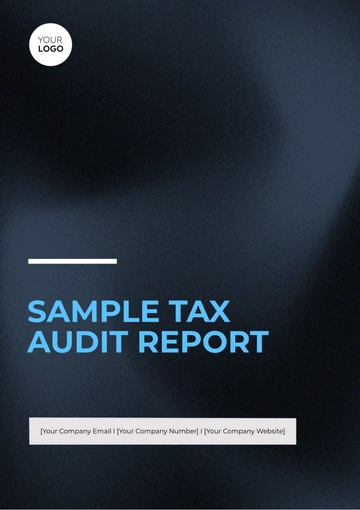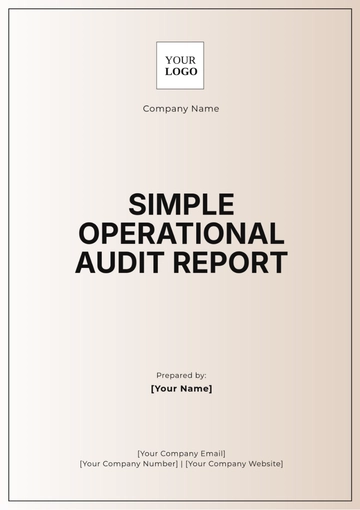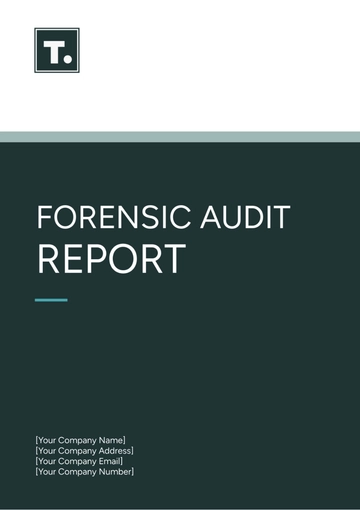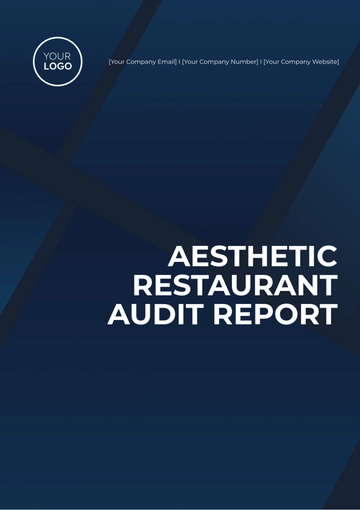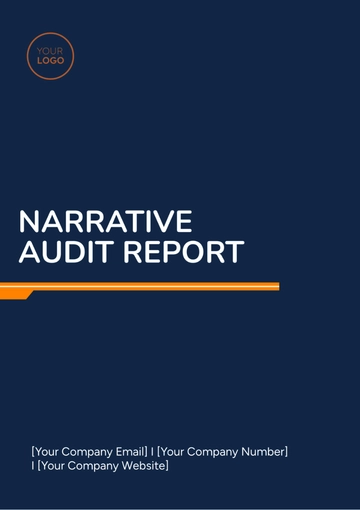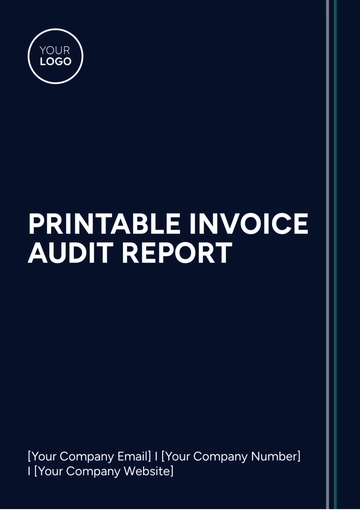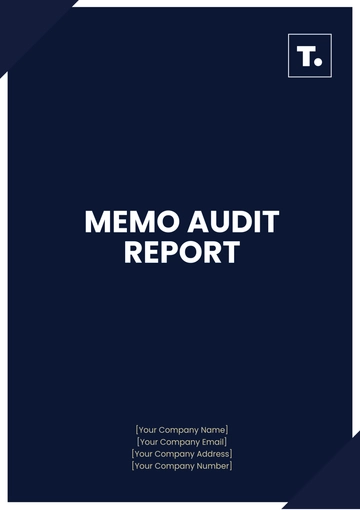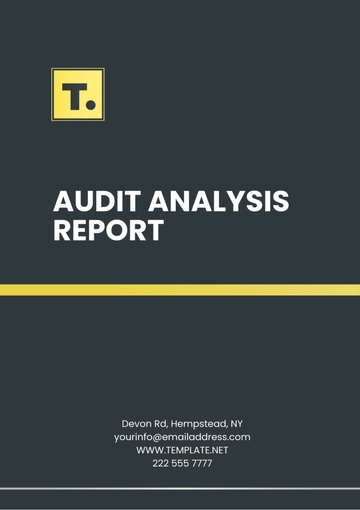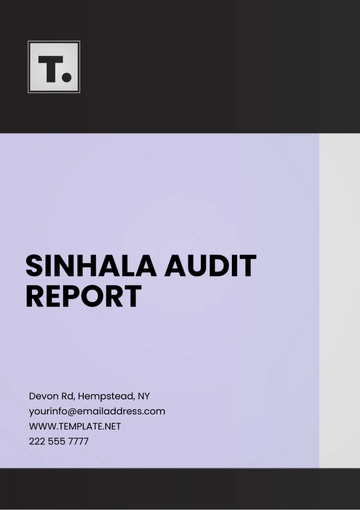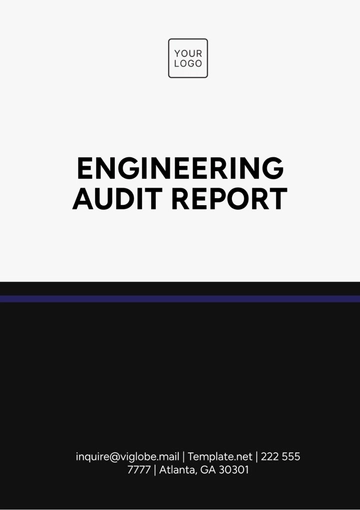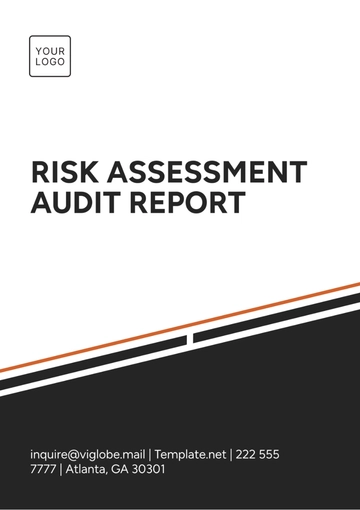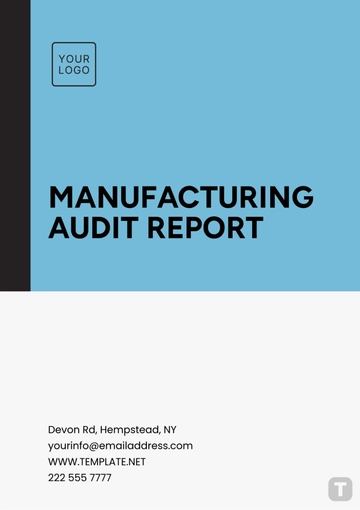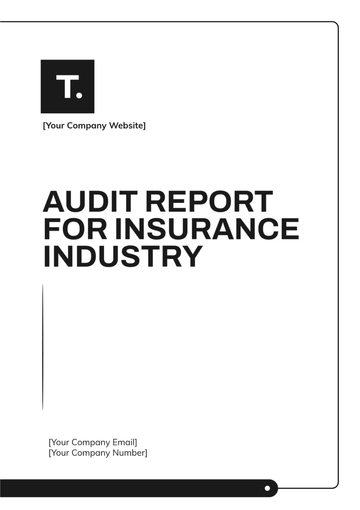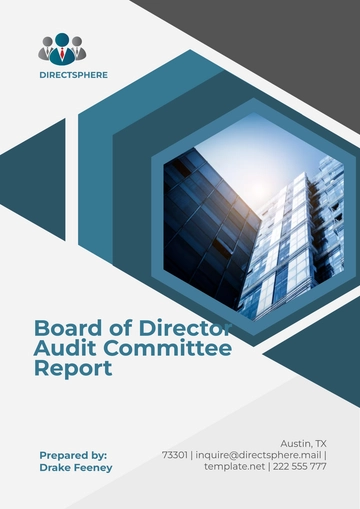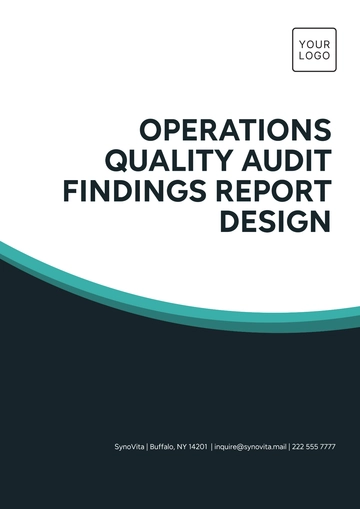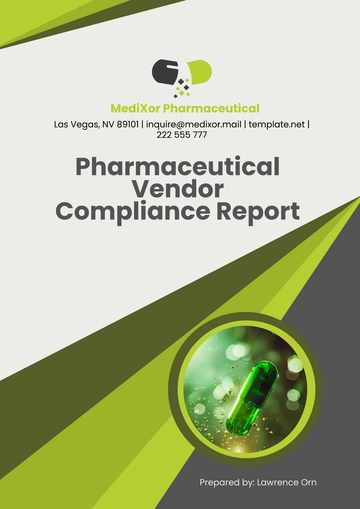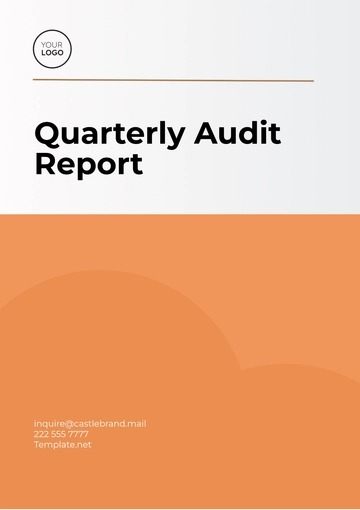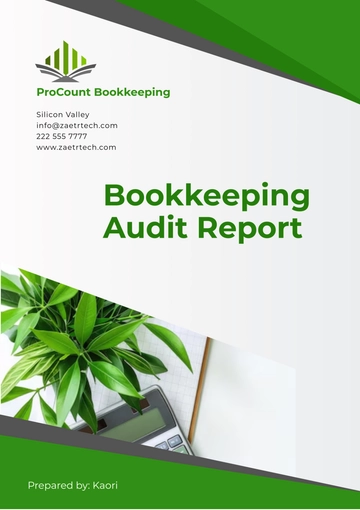Free Agriculture Audit Report
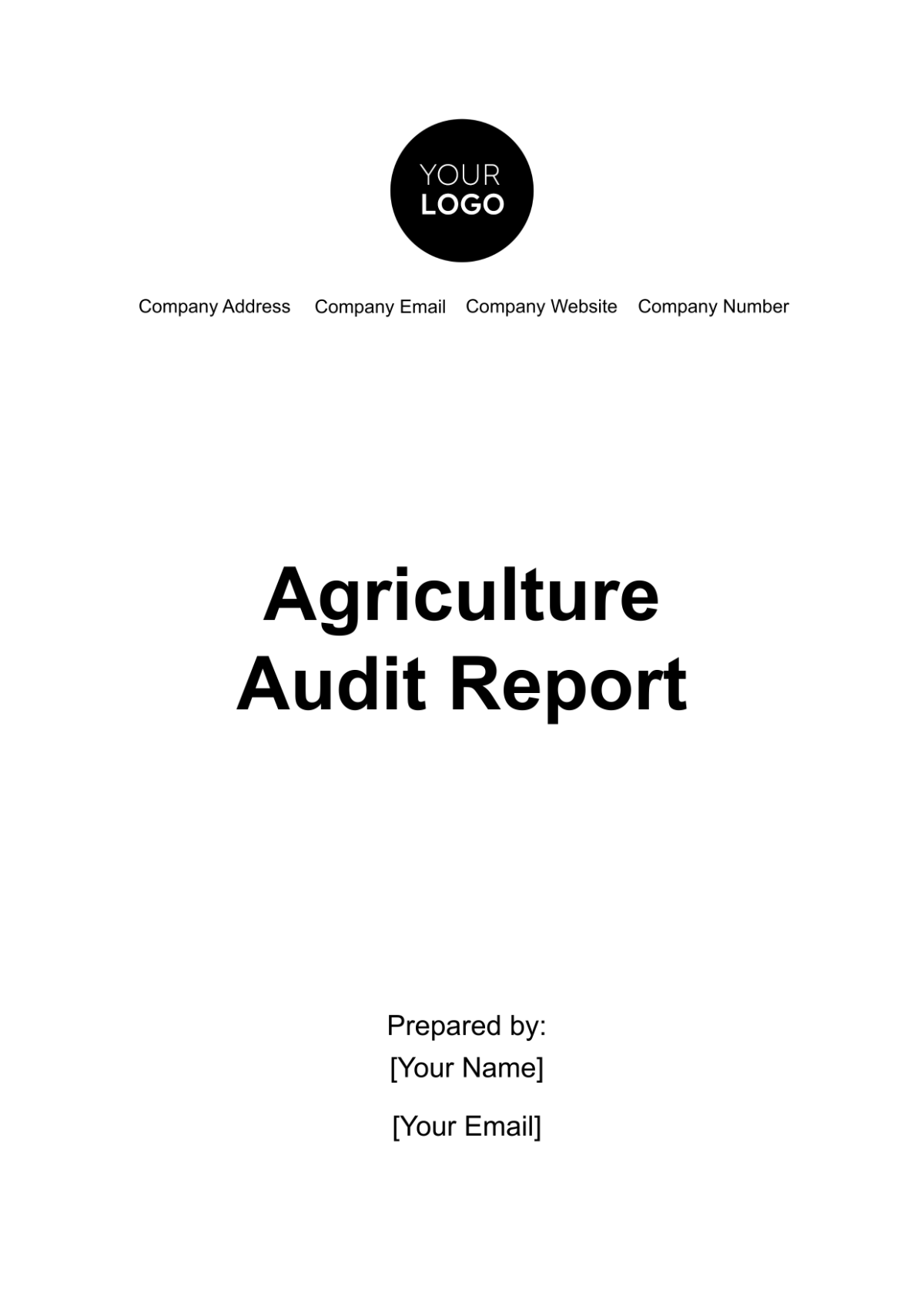
I. Executive Summary
This audit report presents an analysis of the earnings and financial performance of [Your Company Name] for the fiscal year [2055]. The objective of the audit was to ensure the accuracy of financial records, compliance with accounting standards, and to provide insights into the farm's profitability, operational efficiency, and areas for improvement.
Key Findings
Total Earnings: The company achieved total earnings of [$2,500,000] for the year, reflecting robust growth driven by strategic agricultural practices and market demand.
Growth in Revenue: A [12%] increase in revenue compared to the year [2054] indicates successful operational strategies and effective market positioning.
Net Profit Margin: The net profit margin stands at [20%], underscoring the company's efficiency in converting revenue into profit.
II. Audit Objectives
This section delineates the primary objectives of the audit, emphasizing the importance of accuracy, regulatory compliance, and operational analysis in assessing the financial health of [Your Company Name]. These objectives serve as a guiding framework for the entire audit process.
Accuracy Verification: To ensure the accuracy and reliability of the financial statements, including income statements and balance sheets, which are critical for informed decision-making.
Regulatory Compliance: To confirm adherence to state and federal regulations regarding financial reporting within the agricultural sector, thereby minimizing legal risks and ensuring transparency.
Operational Analysis: To identify strengths and weaknesses in the company's operations, providing insights into areas that require strategic improvements or resource allocation.
III. Financial Overview
This section provides a detailed examination of the financial performance of [Your Company Name] through key financial metrics. It is essential for stakeholders to understand the financial landscape to make informed strategic decisions.
Financial Metric | Amount |
|---|---|
Total Revenue | $2,500,000 |
Cost of Goods Sold (COGS) | $1,500,000 |
Gross Profit | $1,000,000 |
Operating Expenses | $300,000 |
Net Profit | $500,000 |
Net Profit Margin | 20% |
The above table illustrates the fundamental financial metrics for the year [2055]. Total revenue was [$2,500,000], marking a significant increase from the previous year. The cost of goods sold (COGS) accounted for [$1,500,000], which, when subtracted from total revenue, resulted in a gross profit of [$1,000,000]. Operating expenses of [$300,000] led to a net profit of [$500,000], translating to a healthy net profit margin of [20%]. This performance reflects effective cost management and strong operational practices.
IV. Revenue Analysis
An in-depth revenue analysis provides insights into the sources of income and trends influencing financial performance. Understanding revenue streams is crucial for identifying opportunities for growth and market expansion.
Source Type | Value |
|---|---|
Crop Sales | $1,800,000 |
Value-Added Products | $400,000 |
Agricultural Consulting Services: | $300,000 |
Total Revenue Percentage:
The revenue sources for [Your Company Name] included crop sales, value-added products, and agricultural consulting services, showcasing a diverse income stream that significantly contributed to overall financial performance. Crop sales were the primary driver, contributing [$1,800,000], thanks to increased crop yields and effective sales strategies. Value-added products generated an additional [$400,000], reflecting the company's commitment to maximizing the value of its agricultural output. Furthermore, agricultural consulting services brought in [$300,000], as the company leveraged its expertise to assist other farms and businesses.
V. Cost Analysis
This section delves into the cost structure of [Your Company Name], analyzing how expenses impact overall profitability. Understanding cost components is essential for developing strategies to enhance operational efficiency.
Cost Type | Amount |
|---|---|
Direct Labor Costs | $700,000 |
Materials and Supplies | $600,000 |
Overhead Costs | $200,000 |
Cost Breakdown:
Direct Labor Costs: [$700,000], which includes wages, benefits, and other employee-related expenses.
Materials and Supplies: [$600,000], covering seeds, fertilizers, pesticides, and other essential farming inputs.
Overhead Costs: [$200,000], which comprises utilities, maintenance, and administrative expenses.
Operational Efficiency: Total operating expenses amounted to [$300,000], encompassing administrative costs, marketing expenditures, and maintenance. This structured management of expenses contributes to the overall profitability of the farm.
Cost Management Strategies: Implementing resource-efficient farming practices, such as precision agriculture and bulk purchasing agreements, has effectively controlled costs and improved margins.
VI. Profitability Assessment
The profitability assessment evaluates how effectively [Your Company Name] converts revenue into profit. This analysis is vital for stakeholders to gauge the company's financial health and identify potential areas for improvement.
Factors Influencing Profitability: Adoption of natural growth methods led to increased crop yields, positively impacting overall profitability. Effective cost management practices reduced operating expenses and enhanced profit margins.
Future Profitability Opportunities: Exploring new markets for value-added products can diversify income streams. Leveraging technology for better crop management and yield forecasting may lead to increased efficiency and profitability.
VII. Recommendations and Conclusion
This section provides actionable recommendations aimed at enhancing financial performance and operational efficiency for [Your Company Name]. By addressing identified areas for improvement, the company can further strengthen its market position.
Diversification of Revenue Streams: Introduce new crop varieties or organic products to capture additional market segments and meet evolving consumer preferences.
Investment in Technology: Consider adopting advanced agricultural technologies, such as precision farming and automated irrigation systems, to increase yields and reduce resource waste.
Strengthening Marketing Efforts: Expand digital marketing initiatives to enhance brand visibility, attract new customers, and leverage social media platforms for direct engagement.
Employee Training Programs: Invest in comprehensive training programs to enhance operational efficiency and equip employees with the skills needed to adapt to evolving market conditions.
This audit report for the year [2055] indicates that [Your Company Name] has successfully achieved significant financial growth and maintained a healthy profit margin. This section summarizes the overall findings and emphasizes the importance of strategic actions for continued success.
- 100% Customizable, free editor
- Access 1 Million+ Templates, photo’s & graphics
- Download or share as a template
- Click and replace photos, graphics, text, backgrounds
- Resize, crop, AI write & more
- Access advanced editor
Ensure compliance and accuracy with the Agriculture Audit Report Template from Template.net. This editable and customizable template allows you to draft thorough audit reports for your agricultural operations. Use our Ai Editor Tool to modify sections and layout, ensuring your audit report is detailed and specific to your needs.
You may also like
- Sales Report
- Daily Report
- Project Report
- Business Report
- Weekly Report
- Incident Report
- Annual Report
- Report Layout
- Report Design
- Progress Report
- Marketing Report
- Company Report
- Monthly Report
- Audit Report
- Status Report
- School Report
- Reports Hr
- Management Report
- Project Status Report
- Handover Report
- Health And Safety Report
- Restaurant Report
- Construction Report
- Research Report
- Evaluation Report
- Investigation Report
- Employee Report
- Advertising Report
- Weekly Status Report
- Project Management Report
- Finance Report
- Service Report
- Technical Report
- Meeting Report
- Quarterly Report
- Inspection Report
- Medical Report
- Test Report
- Summary Report
- Inventory Report
- Valuation Report
- Operations Report
- Payroll Report
- Training Report
- Job Report
- Case Report
- Performance Report
- Board Report
- Internal Audit Report
- Student Report
- Monthly Management Report
- Small Business Report
- Accident Report
- Call Center Report
- Activity Report
- IT and Software Report
- Internship Report
- Visit Report
- Product Report
- Book Report
- Property Report
- Recruitment Report
- University Report
- Event Report
- SEO Report
- Conference Report
- Narrative Report
- Nursing Home Report
- Preschool Report
- Call Report
- Customer Report
- Employee Incident Report
- Accomplishment Report
- Social Media Report
- Work From Home Report
- Security Report
- Damage Report
- Quality Report
- Internal Report
- Nurse Report
- Real Estate Report
- Hotel Report
- Equipment Report
- Credit Report
- Field Report
- Non Profit Report
- Maintenance Report
- News Report
- Survey Report
- Executive Report
- Law Firm Report
- Advertising Agency Report
- Interior Design Report
- Travel Agency Report
- Stock Report
- Salon Report
- Bug Report
- Workplace Report
- Action Report
- Investor Report
- Cleaning Services Report
- Consulting Report
- Freelancer Report
- Site Visit Report
- Trip Report
- Classroom Observation Report
- Vehicle Report
- Final Report
- Software Report
